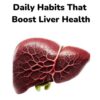If you’ve been trying to conceive for a while, you’ve probably heard the usual advice:
Track your temperature. Watch your cervical mucus. Use an ovulation kit.
Those tools are useful, but they’re not the full picture. Your body, in its quiet brilliance, gives off several subtle signs that it’s preparing for ovulation. These cues are like gentle whispers. easy to miss, but powerful once you learn to notice them.
At Asiwaju Elegboogi Herbal Therapy, we believe that the journey to motherhood begins with a deeper connection to your body’s natural rhythm. When you understand your body’s language, you can support it naturally, through herbs, nourishment, and hormonal balance.
Let’s explore seven lesser-known but scientifically backed signs your body might be ready to release an egg.
1. The Ovulation “Pang” or “Twitch” (Mittelschmerz)
What to Expect:
Some women feel a brief ache or cramp on one side of the lower abdomen during ovulation. It can feel like a small tug, sharp twinge, or pressure.
The Science:
This sensation, known as mittelschmerz, happens when the follicle stretches and releases an egg. Sometimes, a tiny bit of fluid or blood irritates nearby tissue, causing mild discomfort. It usually occurs mid-cycle and lasts from a few minutes to a few hours.
How to Track It:
Notice if the sensation alternates sides each month, your ovaries often take turns releasing eggs. Jot this down in your fertility journal alongside other ovulation signs.
2. The Pre-Ovulation “Glow”
What to Expect:
Your skin may appear clearer, smoother, or more radiant a few days before ovulation. Makeup sits better, and your natural complexion seems brighter.
The Science:
Rising estrogen levels before ovulation increase collagen, hydration, and blood flow, giving your skin a healthy, luminous glow. Nature’s way of making you look and feel your best.
How to Track It:
Watch for this subtle glow in your mirror or photos. It’s often a clue that you’re approaching your fertile window.
3. A Boost in Creativity and Confidence
What to Expect:
You might feel more inspired, expressive, or confident just before ovulation. Ideas flow, social energy rises, and you may even crave new experiences or styles.
The Science:
Estrogen and testosterone peak before ovulation, increasing dopamine and serotonin, your brain’s “feel-good” chemicals. Studies show more activity in the brain’s creative centers during this phase.
How to Track It:
Notice when you feel most motivated, social, or creative. These patterns often mirror your fertile window.
4. A Heightened Sense of Smell
What to Expect:
Perfumes smell stronger, food aromas more intense, and you might be more aware of certain masculine scents.
The Science:
The estrogen and luteinizing hormone (LH) surge before ovulation enhances your olfactory sensitivity, a natural way your body heightens attraction and connection.
How to Track It:
If you suddenly notice scents more vividly, note it down, it may align with your peak fertility days.
5. Breast Tenderness or Sensitivity
What to Expect:
Your breasts may feel slightly fuller or more sensitive a few days before ovulation.
The Science:
Estrogen stimulates growth in milk ducts and increases blood flow to breast tissue. This tenderness differs from the heavier feeling before menstruation, which is caused by progesterone.
How to Track It:
Gently note how your breasts feel through your cycle. Mid-cycle tenderness often signals ovulation is close.
6. Cervical Position and Texture Changes
What to Expect:
Your cervix changes position and texture during your cycle. Near ovulation, it rises higher, softens (like your lips), and opens slightly to allow sperm through.
The Science:
Estrogen makes the cervix more receptive to sperm, while cervical mucus becomes clearer and more slippery, helping sperm reach the egg.
How to Track It:
After washing your hands, gently insert a clean finger into your vagina to feel the cervix daily:
- Infertile phase: low, firm (like your nose), and closed
- Fertile phase: high, soft (like lips), and slightly open
Record your observations alongside other fertility signs.
7. A Drop in Libido After Ovulation
What to Expect:
Your sex drive often peaks just before ovulation and drops once ovulation occurs.
The Science:
Estrogen and testosterone drive pre-ovulatory libido. Once ovulation passes, progesterone rises, creating a calmer, nurturing state but lowering desire.
How to Track It:
Pay attention to your natural rhythm of desire over a few cycles. A noticeable mid-cycle pattern usually reveals your fertile days.
Putting It All Together
Your body doesn’t speak in random symptoms, it speaks in patterns.
When you combine subtle cues like ovulation twitches, mood shifts, and cervical changes with traditional signs like temperature rise or cervical mucus, you gain a fuller understanding of your cycle.
This awareness helps you:
- Time intimacy naturally
- Detect hormonal imbalances early
- Build trust and confidence in your body’s rhythm
At Asiwaju Elegboogi Herbal Therapy, we believe awareness is the first step toward healing. Once you understand your body’s signals, you can support it with gentle, fertility-enhancing herbs, balanced nutrition, and emotional harmony, nurturing both your womb and your confidence.
“Your body isn’t a mystery to solve, it’s a language to learn. Every sign is a syllable of its wisdom.”
A Gentle Reminder
Every woman’s body is unique. You may not experience all these signs, and that’s perfectly normal.
This article is for educational purposes only and not a substitute for medical advice.
If you suspect irregular cycles or have been trying to conceive for 12 months (or 6 months if you’re over 35), consult a healthcare provider or fertility specialist.
Your journey to motherhood is personal, beautiful, and absolutely possible, one cycle of self-awareness at a time.
Explore Herbal Fertility Support with Asiwaju Elegboogi
Empower your body naturally with our Fertility Support Range, expertly crafted herbal blends that promote hormonal balance, egg health, and overall reproductive wellness.
Visit our website to learn more and begin your journey toward natural fertility and womb wellness.



